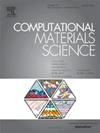新兴光电应用的n-MoS2/p-Si异质结太阳能电池设计与性能分析
IF 3.3
3区 材料科学
Q2 MATERIALS SCIENCE, MULTIDISCIPLINARY
引用次数: 0
摘要
以可持续、绿色和清洁能源为基础的电能转换对现代世界至关重要。太阳能或光伏电池是满足能源需求的主要部分。二硫化钼(MoS2)基异质结太阳能电池等二维材料以其非凡的化学、物理、热、机械、光学和电学稳定性吸引了研究人员。在这项工作中,利用一维太阳能电池电容模拟器(SCAPS-1D)工具模拟了基于n-MoS2/p-Si异质结的太阳能电池的电学行为。通过改变活性层厚度和金属触点来考察二硫化钼基太阳能电池的性能。在不同的工作温度下,对界面缺陷密度、串联和分流电阻的影响也进行了评估。不同参数的最佳组合得到的效率(η)为12.63%,与实验报告值相比已经足够高了。这项研究将为开发二维(2D)材料的高性能太阳能电池提供重要的见解。本文章由计算机程序翻译,如有差异,请以英文原文为准。

Design and performance analysis of n-MoS2/p-Si heterojunction solar cell for emerging optoelectronic applications
Sustainable, green, and clean energy sources based electrical energy conversion are essential to the modern world. A solar or photovoltaic cell is a major part to accomplish the energy needs. Two-dimensional materials such as Molybdenum disulfide (MoS2) based heterojunction solar cells attracted researchers for their extraordinary chemical, physical, thermal, mechanical, optical, and electrical stability. In this work, electrical behaviour of n-MoS2/p-Si heterojunction-based solar cells have been simulated with the help of the Solar Cell Capacitance Simulator One Dimensional (SCAPS-1D) tool. Performances of MoS2-based solar cells were examined by varying the active layer’s thickness and metal contacts. The impact of interfacial defect density, series, and shunt resistance is also evaluated at various working temperatures of these solar cells. An efficiency (η) of 12.63% was obtained using best combinations of different parameters, which is sufficiently high compared to experimentally reported values. This study will provide essential insight to develop high-performance solar cells with two-dimensional (2D) materials.
求助全文
通过发布文献求助,成功后即可免费获取论文全文。
去求助
来源期刊

Computational Materials Science
工程技术-材料科学:综合
CiteScore
6.50
自引率
6.10%
发文量
665
审稿时长
26 days
期刊介绍:
The goal of Computational Materials Science is to report on results that provide new or unique insights into, or significantly expand our understanding of, the properties of materials or phenomena associated with their design, synthesis, processing, characterization, and utilization. To be relevant to the journal, the results should be applied or applicable to specific material systems that are discussed within the submission.
 求助内容:
求助内容: 应助结果提醒方式:
应助结果提醒方式:


